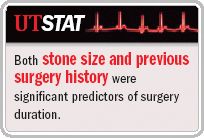Article
Prospective analysis: PCNL safe, effective overall
Atlanta-Results of a prospective, multivariate analysis to identify predictors of perioperative course and clinical outcomes in patients undergoing percutaneous nephrolithotomy (PCNL) for extensive stone disease support the conclusions that in high-volume centers, the safety and efficacy of the procedure are excellent and that they are not significantly influenced by patient-related or sociocultural/ethnic factors.

At the AUA annual meeting here, Peter J. Olbert, MD, reported findings from the study analyzing data collected from patient cohorts in Germany (108 patients) and Malaysia (33 patients) who underwent PCNL at three centers by surgeons having similar experience and using the same type of lithotripter (LithoClast Master, Boston Scientific, Natick, MA).
Univariate and multivariate analyses were performed considering the German and Malaysian patients separately and in combination to determine whether patient sex, age, body mass index, operative side (right/left), stone size (5-mm intervals), study center, previous surgery of the affected kidney, preoperative urinary tract infection, or preoperative hydronephrosis affected outcomes. Outcome variables assessed included stone-free outcome after one session, major complications (eg, hemorrhage, transfusion, conversion to open surgery, fistula, sepsis), duration of surgery, and length of hospital stay (only German data available).

In the multivariate analyses, only stone size was a significant factor, with larger stone burden being predictive of both longer surgery duration and longer length of stay.
"PCNL has largely replaced open stone surgery for patients with extensive stone burden or stones refractory to extracorporeal shock wave lithotripsy because of its limited invasiveness, low complication rates, and excellent therapeutic success," said Dr. Olbert, assistant professor of urology, Philipps-University Medical School, Marburg, Germany. "However, there has been a lack of reproducible and valid data from prospective clinical trials to support this role, as well as a lack of information about potential factors that influence therapeutic success and complication rates of PCNL.
"The findings from this prospective analysis support the conclusion that PCNL is a highly standardized and safe procedure. In addition, perhaps these data can now be used to counsel our patients in more detail and to tell them that, apart from stone size, there is essentially no factor that influences surgical outcome."
Despite their different sociocultural/ethnic backgrounds, the German and Malaysian populations were similar in many respects, including demographic features and proportion of these cohorts with a history of UTI.
Mean stone diameter was statistically significantly larger in the Malaysian group than in the German group (46.1 vs. 27.7 mm), and significantly higher proportions of German patients compared with Malaysians had previous ESWL treatment (55.6% vs. 3.0%) or surgery (27.1% vs 6.0%). The Malaysians were significantly more likely to have infectious stones than Germans (39.4% vs. 19.2%).
Comparison of outcomes between the two patient populations showed no statistically significant nationality-related differences with respect to stone-free rates (83% vs. 92%), major complication rate (11% vs. 22%), or duration of surgery (56 minutes vs. 45 minutes). Data on length of stay were available only for the German group, which had an average hospital stay of 9 days.
Larger stone, longer stay
In the univariate analysis of predictors of surgery duration, significant associations were found for both stone size and previous surgery history, and there was a trend for an effect of patient age.
In the univariate analysis of length of stay, BMI and stone size had predictive value.
"We believe that the influence of stone size on length of stay might be related to a higher rate of auxiliary procedures performed with increasing stone size, such as large-bore nephrostomy tubes or stenting," Dr. Olbert said.





